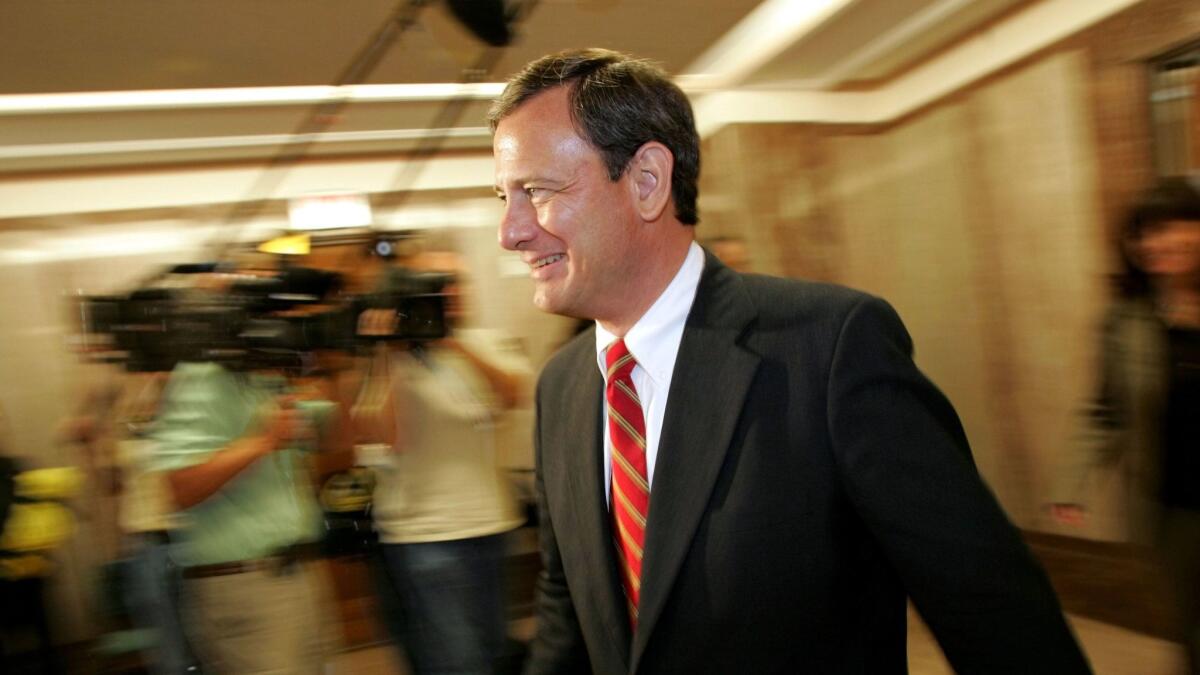Op-Ed: What the Supreme Court could look like with John Roberts as its swing vote

Editor’s note: This article was originally published April 10, 2017. We are resurfacing it from the archives with a new headline in the wake of Justice Anthony Kennedy’s decision to retire from the Supreme Court.
Even before the Senate confirmed Neil Gorsuch as a justice of the Supreme Court, and before it “nuked” the filibuster for nominees, the Trump administration and conservatives were already plotting to fill the next vacancy. Indeed, they have made overtures to swing Justice Anthony M. Kennedy to get him to feel comfortable with retirement. If Kennedy goes, or if a liberal justice gets sick or dies, Democrats have few levers to stop Republicans from confirming a nominee even more conservative than Gorsuch. The future, then, holds a Supreme Court where Chief Justice John G. Roberts Jr. is the swing vote — a scary eventuality for progressives.
Last year was the real moment for the left to act on the Supreme Court. Conservative Justice Antonin Scalia had died, creating the first opportunity in decades to move the court to the left on issues including the environment and civil rights. There could have been a majority to overturn the controversial 2010 Citizens United decision, which has ushered in a new era of big money in politics.
But within an hour of the public announcement of Scalia’s death, Republican Senate Majority leader Mitch McConnell pledged that no nominee from President Obama would get a hearing before the Senate. When Obama nominated a well-respected moderate judge, Merrick Garland of the U.S. Court of Appeals for the D.C. Circuit, Republicans stood their ground — and Democrats failed to take to the streets.
Whether it was because Garland was a middle-of-the road white male, or because liberals did not understand what was at stake, or for some other reason, the court issue did not motivate the left. But it did motivate the right. Republican Sen. Chuck Grassley, chairman of the Senate Judiciary Committee, easily won reelection in Iowa despite his obstruction. According to exit polls, of the one in five voters who said Supreme Court appointments were their “most important issue,” 56% supported Donald Trump and 41% supported Hillary Clinton. Of the 28% of voters who said Supreme Court appointments were not important to their vote, 52% supported Clinton while 39% supported Trump.
Sad as it may be, liberals may have no choice but to put faith in Roberts as a political actor.
Now if Kennedy or Justice Stephen Breyer or Justice Ruth Bader Ginsburg leaves and Trump gets to appoint a replacement, the court will move dramatically to the right. There could well be five justices to overturn Roe vs. Wade, the case guaranteeing women the right to an abortion. The court could hold that all affirmative action plans in public education violate the Constitution. The court could make it much harder to assert claims that restrictive voting laws violate the equal protection clause or the Voting Rights Act. If progressives think the Supreme Court is conservative now, just wait.
With the filibuster gone, the options for the left should another vacancy occur before 2020 are slim. The left could encourage protests and try to pressure moderate senators not to confirm a hard-right nominee, but that seems unlikely.
Sad as it may be, liberals may have no choice but to put faith in Roberts as a political actor. With Justices Samuel A. Alito Jr., Clarence Thomas, Gorsuch and another hard conservative to his right, Roberts could calculate that overturning Roe vs. Wade — and turning the abortion question over to the states — would actually be disastrous for the Republican Party. Suddenly every state election would become a battle over abortion, and many apathetic liberals could turn into motivated ones. Granted, Roberts would almost certainly not fight to save Roe — but he might vote to kill it with 1,000 cuts rather than overturn it outright.
I don’t mean for liberals to find comfort in this scenario. (Roberts likely won’t have any compunction against destroying what is left of affirmative action, or removing the remaining limits on money in politics. Want to donate $100 million to your favorite presidential candidate? No problem.) On the contrary, the possibility that Roberts’ restraint is the best hope for preserving progressive constitutional rulings shows us that the left is in a truly poor position.
The only real solution is for Democrats to pray for the current justices’ good health — and then to take back the presidency and the Senate. And once they do, perhaps they’ll play hardball themselves by increasing the number of justices on the court and packing it with liberals.
Richard L. Hasen is a professor of law and political science at the UC Irvine School of Law, and author of “Plutocrats United” and “The Voting Wars.”
Follow the Opinion section on Twitter @latimesopinion or Facebook
MORE FROM OPINION
Trump told Obama not to attack Syria; now he does just that
Instead of taxes, make corporations give the government stock
More to Read
A cure for the common opinion
Get thought-provoking perspectives with our weekly newsletter.
You may occasionally receive promotional content from the Los Angeles Times.










